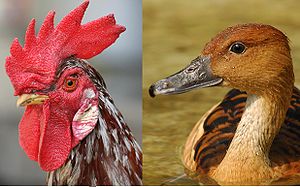Galloanserae
| Galloanserae | ||||||||||||
|---|---|---|---|---|---|---|---|---|---|---|---|---|

|
||||||||||||
| Systematics | ||||||||||||
|
||||||||||||
| Scientific name | ||||||||||||
| Galloanserae | ||||||||||||
| Sibley , Ahlquist & Monroe , 1988 | ||||||||||||
| Orders | ||||||||||||
|
The Galloanserae ( Lat. Gallus = "cock" and Anser = "goose") are next to the Neoaves one of two large groups of the new jaw birds and contain the eponymous orders of the hen birds (Galliformes) and geese birds (Anseriformes) as well as extinct groups that are closer to them are related than to the Neoaves, including possibly the Pelagornithidae and the Gastornithidae . The young of the Galloanserae are fleeing nests.
Common derived osteological features of the fowl and geese are found in the skull: the basipterygoid processes are egg-shaped and firmly attached, the quadratum has only two mandibular joint cartilages and the lower jaw shows long, blade-shaped retro-articular processes. Furthermore, almost all analyzes of molecular data (e.g. mitochondrial DNA; DNA of the cell nucleus; DNA-DNA hybridization) confirm the close relationship between the two groups.
The first evidence for galloanserine birds is likely to be found in skeletal remains from the late Cretaceous period, which were described as Palintropus , Vegavis and Austinornis .
In March 2020, Belgian scientists described a dove-sized 66.7 million year old fossil bird ( Asteriornis maastrichtensis ) that shows features of geese and chickens.
Systematics
According to the review by Mayr (2009), the Galloanserae show the following relationships (supplemented by Ichthyornis and the Carinatae according to Benton, 2005):
| Carinatae |
|
||||||||||||||||||||||||||||||||||||
|
|
supporting documents
- ^ A b C. G. Sibley, JE Ahlquist, BL Monroe: A classification of the living birds of the world based on DNA-DNA hybridization studies. Auk 105, 1988, pp. 409-423.
- ^ E. Bourdon: Osteological evidence for sister group relationship between pseudo-toothed birds (Aves: Odontopterygiformes) and waterfowls (Anseriformes). Natural Sciences 92, 2005, pp. 586-591.
- ^ A. Andors: Reappraisal of the Eocene groundbird Diatryma (Aves: Anserimorphae). In: KE Campbell (Ed.): Papers in avian paleontology honoring Pierce Brodkorb. National History Museum of Los Angeles City Science Series 36, pp. 109-125, 1992.
- ↑ a b c G. Mayr: Paleogene fossil birds. Springer, Berlin / Heidelberg, 2009, 262 pages, ISBN 3540896279
- ^ CG Sibley, JE Ahlquist: Phylogeny and classification of birds: a study in molecular evolution. Yale University Press, New Haven, 1990.
- ↑ PGP Ericson, CL Anderson, T. Britton, A. Elzanowski, US Johansson, M. Kallersjo, JI Ohlson, TJ Parsons, D. Zuccon, G. Mayr: Diversification of Neoaves: integration of molecular sequence data and fossils. Biological Letters 2 (4), 2006, pp. 543-547. doi : 10.1098 / rsbl.2006.0523 .
- ↑ S. Hope: The Mesozoic radiation of Neornithes. In: Chiappe, L. & Witmer, L. (eds.), Mesozoic Birds: Above the Heads of Dinosaurs, 2002, pp. 339-388.
- ^ Field, Daniel J .; Benito, Juan; Chen, Albert; Hunt, John WM; Ksepka, Daniel T. (March 18, 2020). Late Cretaceous neornithine from Europe illuminates the origins of crown birds . Nature. 579 (7799): 397-401. doi: 10.1038 / s41586-020-2096-0. ISSN 1476-4687.
- ^ MJ Benton: 'Vertebrate Palaeontology. 3rd edition, Blackwell, Oxford, 2005, 455 pp. ISBN 0-632-05637-1